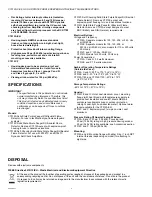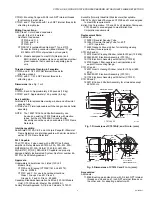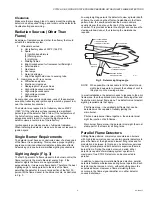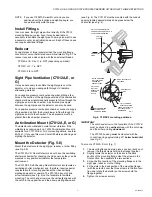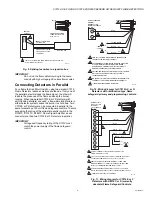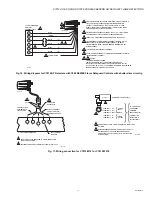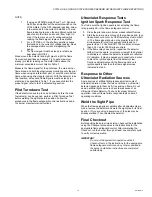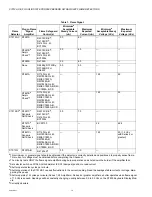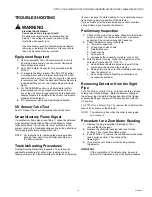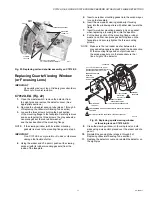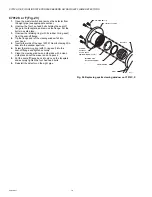
C7012A,C,E,F,G SOLID STATE PURPLE PEEPER® ULTRAVIOLET FLAME DETECTORS
5
60-2398-17
Clearance
Make sure there is enough room to easily mount the sight pipe,
detector and all required fittings, and to remove the detector for
troubleshooting and servicing.
Radiation Sources (Other Than
Flame)
Examples of radiation sources (other than flame) that could
actuate the detection system:
1.
Ultraviolet sources:
a. Hot refractory above 2300°F (1260°C).
b. Spark:
(1) Ignition transformers.
(2) Welding arcs.
(3) Lightning.
c. Welding flames.
d. Bright incandescent or fluorescent artificial light.
e. Solar radiation.
f. Gas lasers.
g. Sun lamps.
h. Germicidal lamps.
i.
Bright flashlight held close to sensing tube.
2.
Gamma ray and X-ray sources:
a. Diffraction analyzers.
b. Electron microscopes.
c. Radiographic X-ray machines.
d. High voltage vacuum switches.
e. High voltage condensers.
f. High voltage coronas.
g. Radioisotopes.
Except under unusual circumstances, none of these sources
except hot refractory and ignition spark would be present in or
near the combustion chamber.
The detector may respond to hot refractory above 2300°F
(1260°C) if the refractory surface represents a significant
percentage of the detector field of view. If the temperature of
the hot refractory causes the flame relay (in the flame
safeguard control) to pull in, re-aim the sight pipe so the
detector views a cooler area of the refractory.
Ignition spark is an intense source of ultraviolet radiation.
When installing the detector, make sure it does not respond to
ignition spark.
Single Burner Requirements
The detector must have an unobstructed view of a steady part
of the flame it is supervising. This requires a proper sighting
angle and minimized ultraviolet radiation attenuation effects.
Supervising only one burner simplifies sighting requirements.
Sighting Angle (Fig. 3)
The first 30 percent of a flame closest to the burner nozzle (the
flame root) emits the most ultraviolet energy. Also, if the
detector sights the flame at an angle instead of
perpendicularly, it views more flame depth. Therefore, the best
sighting angle is nearly parallel to the axis of the flame,
permitting the detector to view a large portion of the first 30
percent of the flame closest to the burner nozzle, as illustrated
in Fig. 3.
Low angle sighting permits the detector to view a greater depth
of flame, thus reducing the effects of instabilities in the flame
pattern. Also, the environment near the burner nozzle is
usually cleaner than at any other part of the combustion
chamber. This provides a clearer line of sight and can keep the
viewing window cleaner, thus reducing the maintenance
required.
Fig. 3. Detector sighting angle.
NOTE: When possible, it is desirable to tilt the detector and
sight pipe downward to prevent the buildup of soot in
the pipe or on the viewing window.
In most installations, the detector needs to respond to the pilot
flame alone, then the pilot and main burner flame together, and
finally the main burner flame alone. The detector must meet all
sighting requirements that apply:
Pilot flame alone—the smallest pilot flame that can be
detected must be capable of reliably igniting the
main burner.
Pilot and main burner flame together—the detector must
sight the junction of both flames.
Main burner flame alone—the detector must sight the most
stable part of the flame for all firing rates.
Parallel Flame Detectors
Shifting flame patterns, commonly encountered on burners
with high turndown ratios, can require two parallel detectors to
prove the flame at the highest and lowest firing rates and for
modulation in between. In this case, one detector supervises
the pilot (interrupted) and both detectors supervise the main
burner flame. During the main burner run period, either
detector is capable of maintaining system operation. A
maximum of two C7012 Detectors can be connected in
parallel.
In addition to assuring more reliable flame detection, parallel
detectors facilitate maintenance during burner operation. Each
detector can be removed, in turn, without shutting down the
supervised burner. However, a flame simulating failure
occurring in the flame signal amplifier or in either detector
causes a shutdown.
FLAME DEPTH–
ANGLE VIEW
M1956
DETECTOR IN GOOD
SIGHTING POSITION
(LOW ANGLE SIGHTING)
UNBURNED FUEL
FLAME DEPTH–
PERPENDICULAR VIEW
BURNER
NOZZLE
DETECTOR IN POOR
SIGHTING POSITION


